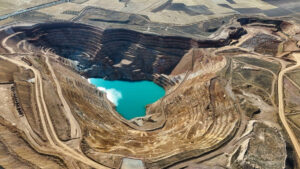Lefroy’s explorers take off to test promising Burns copper-gold intrusion

Lefroy's drill program follows-up on promising drill intersections. Pic: RichVintage via Getty Images.
Lefroy has started reverse circulation drilling at its Burns copper-gold prospect to follow-up on recent gold intersections within the Lefroy Palaeochannel.
This is aimed at evaluating and expanding the footprint of the recently reported multiple gold intersections made by hole LEFR307 that tested the centre of the large Burns intrusion located 1,600m to the west of the established Burns copper-gold system.
Notable results at LEFR307 are a new palaeochannel hosted intercept of 17m grading 1.7 grams per tonne (g/t) gold from a depth of 75m that includes a higher grade zone of 7m at 3.68g/t gold from 80m along with a 11m interval grading 0.42g/t gold within the monzodiorite basement.
Lefroy Exploration (ASX:LEX) plans to drill 20 vertical holes totalling 2,000m to cover about 1.5km of the palaeochannel on a broad 320m by 80m pattern.
Results from this program will guide more detailed follow-up pattern RC drilling.
Separately, the company will drill two angled RC holes 20m to the north and south of LEFR260, which intersected 38m at 7.63g/t gold and 0.56% copper from a depth of 134m.
These holes will provide improved control of this high-grade zone in advance of planning of a +1000m deep diamond hole targeting the depth extension to and geological character of the intrusion related copper-gold system.
This deep hole is co-funded by the West Australian government’s Exploration Incentive Scheme (EIS).
“We are very keen to be back out RC drilling at Burns firstly with an initial broad test of the palaeochannel system to follow up the intersection in LEFR307, and secondly to focus on the high-grade mineralisation adjacent to discovery hole LEFR260,” managing director Wade Johnson said.
“We will prioritise selected samples from this program for analysis, the results from which will assist in planning further RC drilling along the channel, and the siting of the +1km EIS co-funded diamond hole to probe the depth of this unique intrusion related copper-gold system.”
Drill program
Holes LEFR306 and LEFR307 were drilled in late 2021 to evaluate the untested core and margin to the large Burns intrusion with the latter also following up on a prior subtle gold anomaly hosted in transported cover in a historical aircore hole.
LEFR307 established that the basal sediments in the palaeochannel at Burns can host significant gold mineralisation and that the monzodiorite basement beneath is also a host to primary gold mineralisation.
Notably, the palaeochannel is part of the larger Lefroy palaeo-drainage that extends east from the St Ives gold operation and where gold mining is conducted at the Neptune pit.
Lefroy’s 20-hole RC drill program will assess the interpreted deeper part of the channel at Burns where the gold mineralised basal gravels are interpreted to occur.
Each hole will have a planned downhole depth of about 100m to both test the channel sediments and the underlying bedrock.
This article was developed in collaboration with Lefroy Exploration, a Stockhead advertiser at the time of publishing.
This article does not constitute financial product advice. You should consider obtaining independent advice before making any financial decisions.
Related Topics

UNLOCK INSIGHTS
Discover the untold stories of emerging ASX stocks.
Daily news and expert analysis, it's free to subscribe.
By proceeding, you confirm you understand that we handle personal information in accordance with our Privacy Policy.








